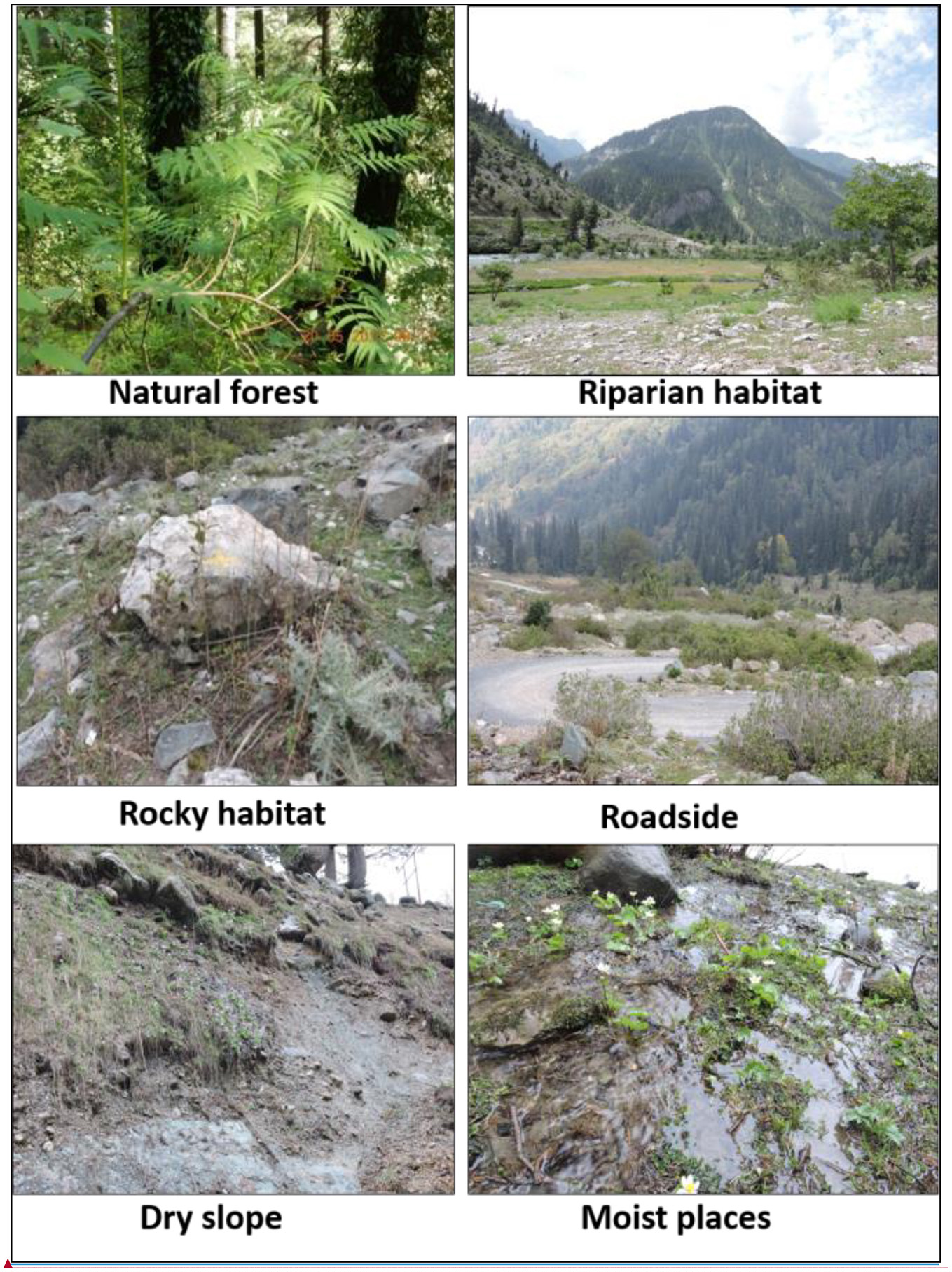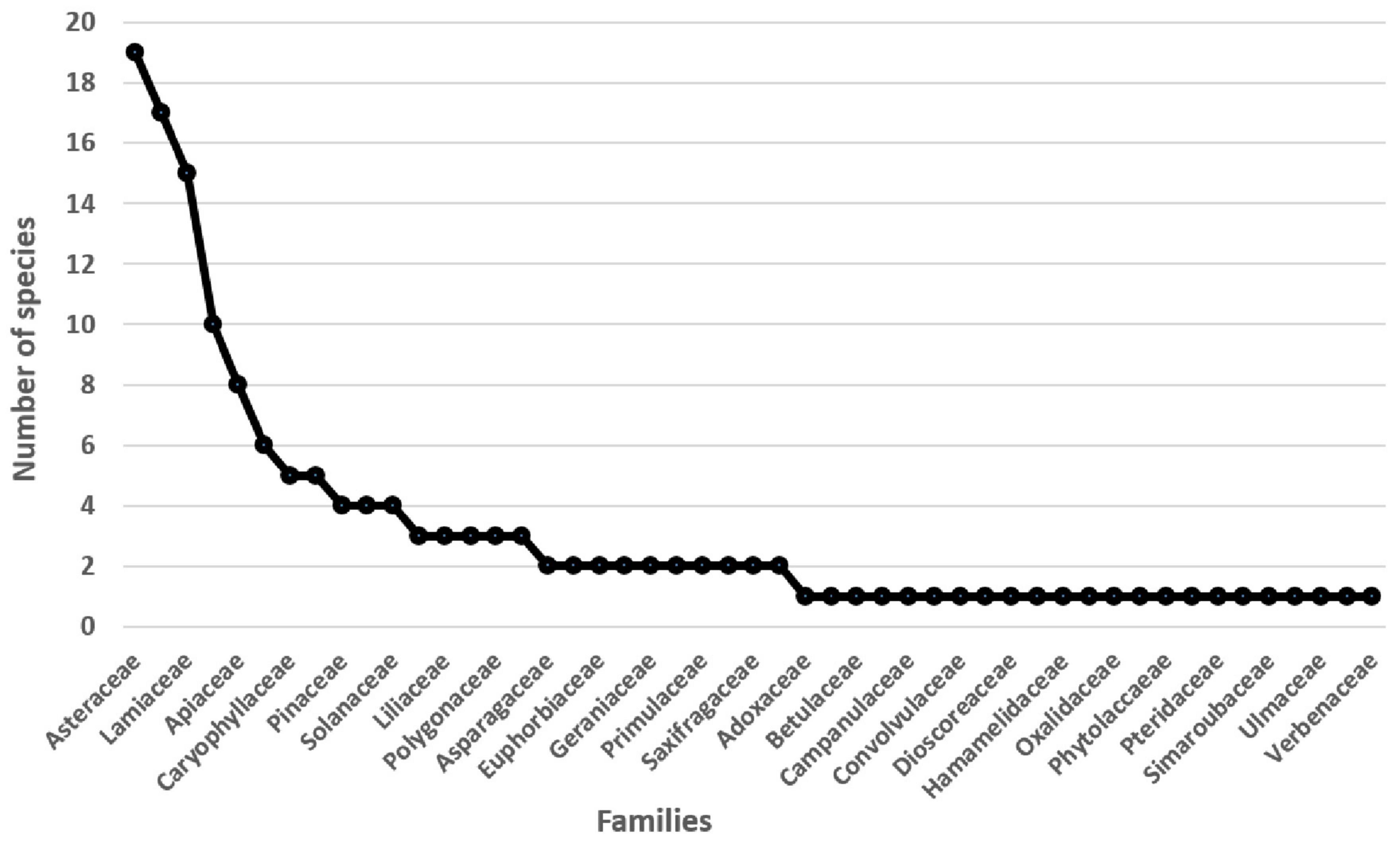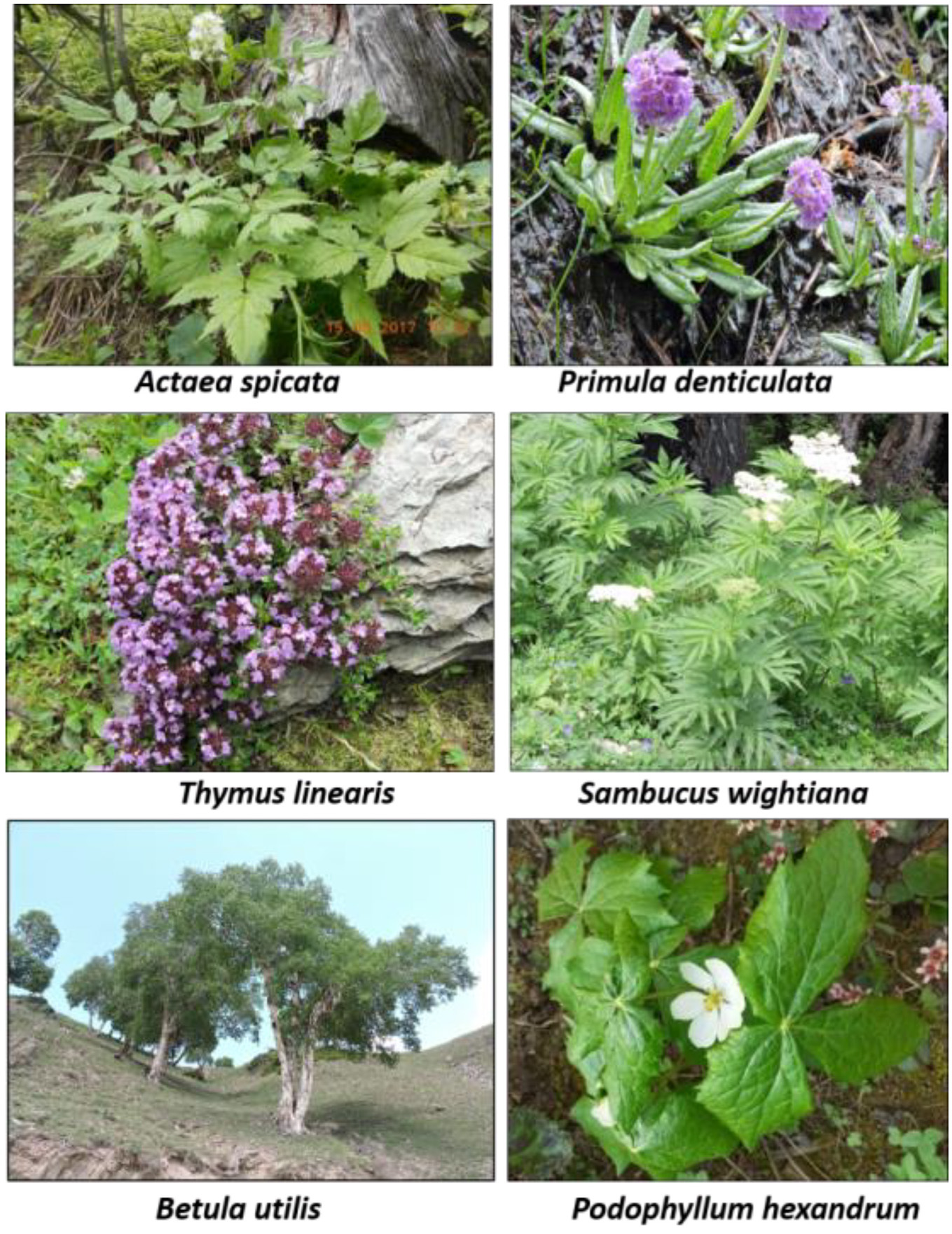- 1Department of Ethnobotany, Institute of Botany, Ilia State University, Tbilisi, Georgia
- 2Department of Botany, Glocal University Saharanpur, Saharanpur, India
- 3Department of Botany, Government Degree College (Women), Kupwara, India
- 4Department of Botany, University of Okara, Okara, Pakistan
- 5Department of Botany, Institute of Life Sciences, State Museum of Natural History, Karlsruhe, Germany
- 6Department of Food Industries, Faculty of Agriculture, Damietta University, Damietta, Egypt
- 7Department of Plant Production, College of Food and Agriculture Sciences, King Saud University, Riyadh, Saudi Arabia
Introduction: Scientific documentation of the qualitative forest vegetation parameters of a biogeographical area provides baseline information to guide conservation strategies and design policies for biodiversity management regulations.
Methods: We present one of the most comprehensive qualitative vegetation analyses to evaluate the entire structure and function of an ecosystem in the remote northern part of the Kashmir Himalaya, India. Several multivariate ecological community analyses were conducted after determining the presence of plant species in the various habitats using a random sampling technique.
Results: In total, 155 plant species belonging to 120 genera and 49 families occurred in the area. Asteraceae was the largest family (12% of plant species) followed by Rosaceae (11%). The patterns of species distribution across families were uneven, with 50% of the species belonging to only 7 families, and 23 families being monotypic. In terms of functional groups, the herbaceous growth form dominated. Therophytes were the dominant life form, indicating that the vegetation was disturbed. According to the phytogeographical research, 65% of the species documented in the study area were native, 15% were invasive, 14% naturalized, and 5% being casual. The majority (30%) of exotic species were reported along roadsides. Of all the species found, 39% grew in their natural habitats, such as forests, and 11% were scattered along roadsides. Plant species were grouped in five different clusters based on their floristic similarity. According to the estimated diversity indices, natural forest has the greatest values for Shannon’s and Simpson’s index. We found that the study area serves as the natural habitat for several significant, endangered medicinal plants, including Arnebia benthamii, Bergenia ciliata, Delphinium roylei, Gentiana kurroo, Phytolacca acinosa, Saussurea costus, and Trillium govanianum. Therefore, we recommend that human intervention in natural regeneration efforts be prioritized in these habitats to increase the population of these species.
Conclusion: Examining species features from the perspective of functional groups contributes to our understanding of the ecological aspects of the flora. It may also be useful in developing management plans to ensure long-term management of forest landscapes in this remote Himalayan region.
Introduction
Floristic diversity is an important element of ecosystems (Hua et al., 2022). This diversity includes the plant species diversity of a particular area representing the local flora of a given area (Qian et al., 2021). Taxonomy is concerned with their identification and classification of species (Barkley et al., 2004). Floristic and taxonomic studies provide efficient information about different aspects of an ecosystem, including nomenclature, distribution, ecology and utility of plant species of an area (Grime et al., 2014; Haq et al., 2022d). While information on plants of many regions has long been available online via checklists (Safidkon et al., 2003), comprehensive floristic studies are still necessary to document the whole plant diversity of any geographic region (Noss, 1983). Lack of such studies strongly limits the scientific inquiry into plants (Kier et al., 2005), and is needed to ultimately understand how plant communities are structured and distributed.
Among the various ecological attributes of plant communities, floristic composition and ecological diversity are the most important ones that are influenced by a variety of biotic and abiotic factors (Khan et al., 2018; Solefack et al., 2018). The understanding of linkages among plants diversity and its ecological functions is critical for understanding the adjustment of plant communities, and how they adopt toward specific habitats (Rahman et al., 2019a; Altaf et al., 2022). Lifeform and habit are the two important physiognomic features that are being widely used while investigating vegetation (Haq et al., 2019). Studying functional plant traits of a given region is an important tool that helps in understanding the relationship between environmental variables and plant community structure and distribution, ultimately revealing the biological functions of individual species in a community (Vakhlamova et al., 2016).
The Himalayan Mountain Range is a prominent biogeographic ecoregion that shows great variation in topography and climate, and thus harbors significant plant diversity (Olson et al., 2001). This mountain ecosystem has been recognized as a global biodiversity hotspot due to its significant biodiversity and huge endemism (Myers et al., 2000). The Kashmir Himalaya, part of Indian Himalayan Region, has been considered as a promising floristic region with high endemism (Mahar et al., 2009). Nonetheless, many remote areas of this biodiversity-rich region have not received much attention as far as floristic and ecological investigations are concerned, which is especially the case of remote mountains region in Kashmir Himalayas. The capability and productivity of the Himalayan forest ecosystem have decreased as a result of numerous stressors, including anthropogenic factors (such as over-exploitation of forest resources and the spread of invasive species), environmental (climate, slope, soil), fire incidences, and declining biological diversity (Haq et al., 2020). Floristic and ecological studies are crucial to advancing our understanding of the distribution and composition of plant communities in biodiversity hotspots. It is crucial and most effective to record qualitative forest vegetation parameters in order to preserve floristic diversity in the future and utilize biological resources sustainably. Keeping this in view, we focused on the following objectives: (i) to record the floristic composition of the vegetation in the region. (ii) What are the patterns of the emergent ecological traits groups in the flora in this region (iii) to find out the contribution of native and alien elements in the region vegetation and (iv) to find out the forest species pool shows habitat filtering in the region.
Given the ecological and economic significance of the forest vegetation under consideration, the findings of this study can guide sustainable biodiversity management and habitat restoration, particularly in invaded habitats in this Himalayan region, with global implications.
Materials and methods
Research area
The study area one of the remotest Tehsil of District Bandipore, Jammu and Kashmir, India. The Gurez valley is situated in the high-altitude Kashmir Himalaya, about 86 kms from Bandipore and 146 kms from the regions summer capital (Srinagar) (Figure 1). The Gurez valley is at an altitude of ranges from 2,400 to 3,500 masl and is mostly inhabited by Pahari and Gujjar tribes. The study area includes fifteen Panchayats (village administrative units) with about 30,000 inhabitants. Dawar is known as the main town in the area. Due to heavy snowfall (approx. 1.5–1.8 m), the area remains disconnected from the rest of the region for about 6 months a year, as Razdan Pass is completely closed in the winter. It has a dry and mild climate. The valley is vital for wildlife tourism because it is surrounded by high mountains and steep gorges that are drained by the Kishanganga River. It also supports a variety of vegetation, dense forests, and a wealth of species.
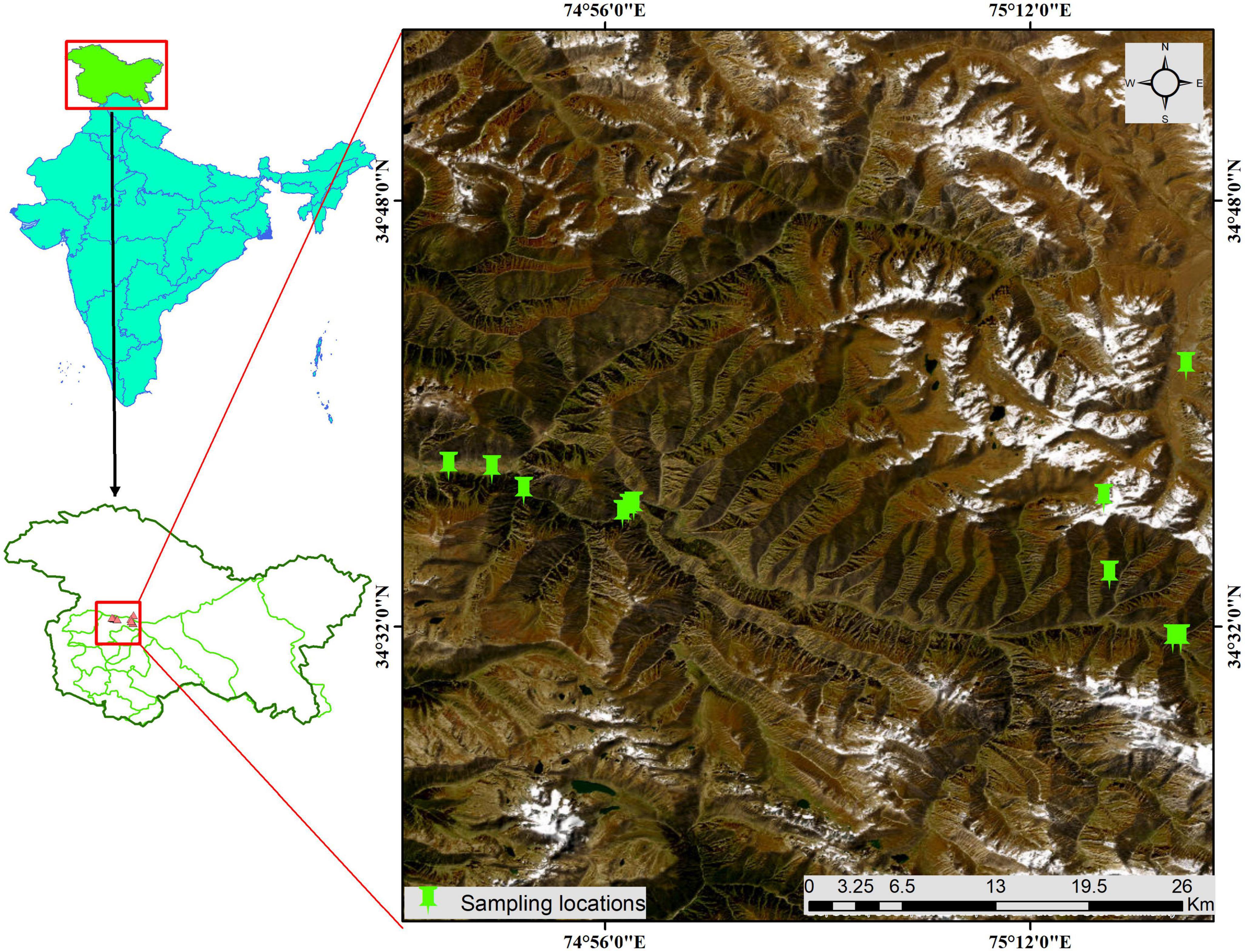
Figure 1. Map of study area (A) India (B) Jammu and Kashmir (C) Bandipora district and point showing the Gurez Valley in the Kashmir Himalaya, India (generated using ArcGIS version,10.5).
Field survey
Frequent surveys were conducted to obtain a better understanding of the research area and field data were collected during in various expeditions 2019–2021. Sites for the floristic studies were chosen using a random sampling technique to guarantee that plant species from various habitats had an equal chance of being sampled. The quadrat method was used to record floristic composition and functional characteristics to improve vegetation documentation (Haq et al., 2020). We set up 36 0.1 ha plots for field sampling across different habitats in the study area. Within each 0.1 ha plot, two 5 m2 plots were placed in opposite corners estimate shrub diversity. For the herbaceous layer, 5 plots of size 1 m2 were laid (4 in each corner 0.1 ha plot and one in the center). In total, 32 plots for trees, 64 (2 plots × 32 = 64) plots for shrubs and 160 (5 plots × 32 = 160) plots for herbs were sampled in the present study. Field data about each specimen of plant material was meticulously recorded during field studies. In order to serve as herbarium voucher specimens, plant specimens were collected from the field, identified using taxonomic literature, and then authenticated by comparing the plant specimens with material in the KASH herbarium. Ecological traits (like Raunkiaer’s life-form, plant habit, phyto-geographical, life span) of each species were recorded during sampling, following Raunkiaer (1934), and Pérez-Harguindeguy et al. (2016). Furthermore, habitat characteristics of each plant species were categorized as Dry slope (DS), Moist places (MP), Natural forest (FR), Shady places (SP), Riparian vegetation (RV), Rock crevice (RC), Roadside (RS), Crop fields (CF), Vegetable garden (VG) (Plate 1). The range of native phyto-geographically reported plant specimens was acquired by using secondary sources like manuals, Flora and specified internet web pages (GRIN: Germplasm Resource Information Network).1 Based on the available data, all plant specimens were categorized into native and exotic species.
Data analysis
To investigate the relationships between ecological variables and plant compositions, heat map and clustering analysis were employed (Rahman et al., 2019a; Haq et al., 2021d). The heat map displayed the distribution of species using presence/absence data, and the clustering algorithm grouped species with similar habitat categories. The Sørensen (1948) similarity coefficient based on presence/absence data was used to identify significant differences among different habitat types and microclimatic similarities (Dalirsefat et al., 2009). In order to identify hypothetical variables (components) that explain the majority of the variance in our multidimensional data, Non-Metric Multidimensional Scaling (NMDS) was utilized. The contribution of various Raunkiaer’s life forms was visualized using chord diagrams generated with the circlize package (Gu et al., 2014). Subsequently, we computed three diversity indices, namely, species richness, Shannon and Simpson, based on presence/absence of species for all habitats, and all plots and analyses were performed using R software version 4.0.0 (R Core Team, 2020).
Results
Floristic composition and distribution
Based on the present investigation, 155 plant species from 120 genera and 49 families were reported in the current study area (Table 1). The distribution of the species among the 49 families was unequal; just 7 families held half of the species, while 42 families held the other half. 23 families were monotypic (Figure 2). The top five plant families were Asteraceae (19 species, or 12% of all species), Rosaceae (17 species, or 11% of all species), Lamiaceae (15 species, or 10%), Ranunculaceae (10 species, or 6%), and Apiaceae (8 species, or 5%) (Table 1).

Table 1. Floristic composition and life span traits of the forest vegetation in Gurez Valley of Kashmir Himalaya, India.
Species distribution among growth form types
In the current study, the highest number of plant species (111) were herbaceous plants (72% of all species), followed by 21 tree species (13%), 15 shrubs (10%), four climbers (3%), and four sub-shrubs (2%) (Table 1). Most of the tree species growing in the valley were deciduous (e.g., Aesculus indica, Acer caesium, Betula utilis, Celtis australis, Prunus armeniaca, Prunus cornuta, Populus nigra, and Ulmus villosa). A few coniferous tree species (e.g., Abies pindrow, Cedrus deodara, Picea smithiana, Pinus wallichiana, and Taxus wallichiana) were also reported. Shrubs included Rosa webbiana, Berberis lyceum, Rubus ulmifolius, Parrotiopsis jacquemontiana, and Indigofera heterantha. Important medicinal herbs reported from the valley were Ajuga parviflora, Bergenia ciliate, Delphinium roylei, Gentiana kurroo, Heracleum candicans, Phytolacca acinosa, Saussurea costus, Taraxacum officinale, and Trillium govanianum (Table 1). The representative plants species documented in the different habitats of the study area are shown in Plate 2.
Species distribution among life-form traits
About 35% of the species (54 species) were therophytes which constituted the dominant life form, followed by 29 species of hemicryptophytes (19%), chamaephytes and geophytes with 15 species each (10%), megaphanerophytes with 13 species (8%), nanophanerophytes with 12 species (8%), cryptophytes and mesophanerophytes with 7 species each (4%), microphanerophytes with 2 species (1%), and parasitic forms with a single species (1%) (Figure 3). Majority of the plant species (129) in the studied valley were represented by perennials (83%) followed by annuals with 23 species (15%), and biennials with three species (2%). According to the phyto-geographical research, 65% of the species documented in the study area were native, with the remaining 15% being invasive, 14% being naturalized, and 5% being casual (Figure 4 and Table 1). The majority (30%) of exotic species were reported on the roadside, followed by natural forests (23%), crop fields (17%), dry slopes (16%), shady areas (5%), moist places, and riparian zones (4% each).
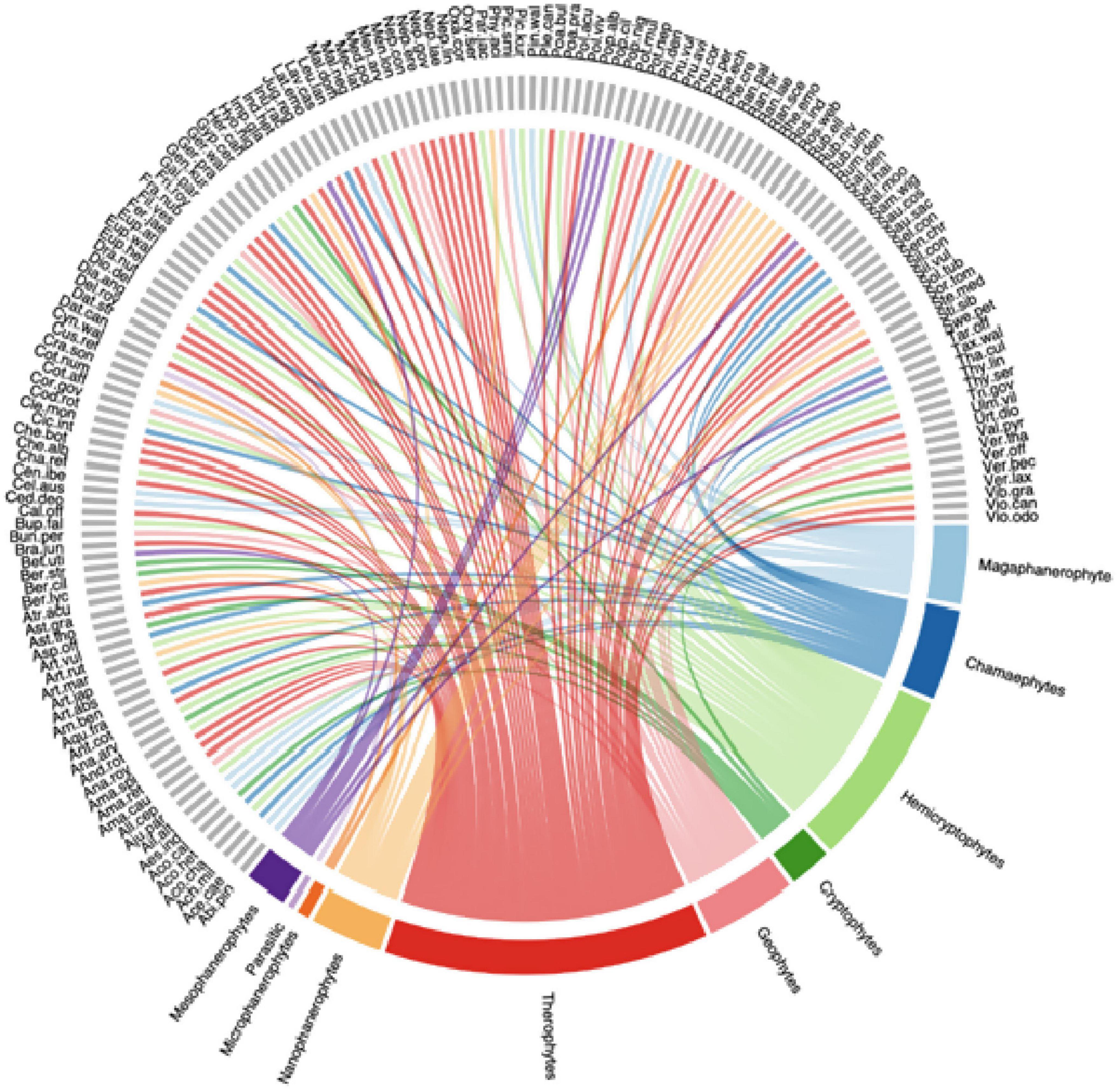
Figure 3. Plant species distribution according to Raunkiaer’s life form of the vegetation in Gurez valley, Kashmir Himalaya, India.
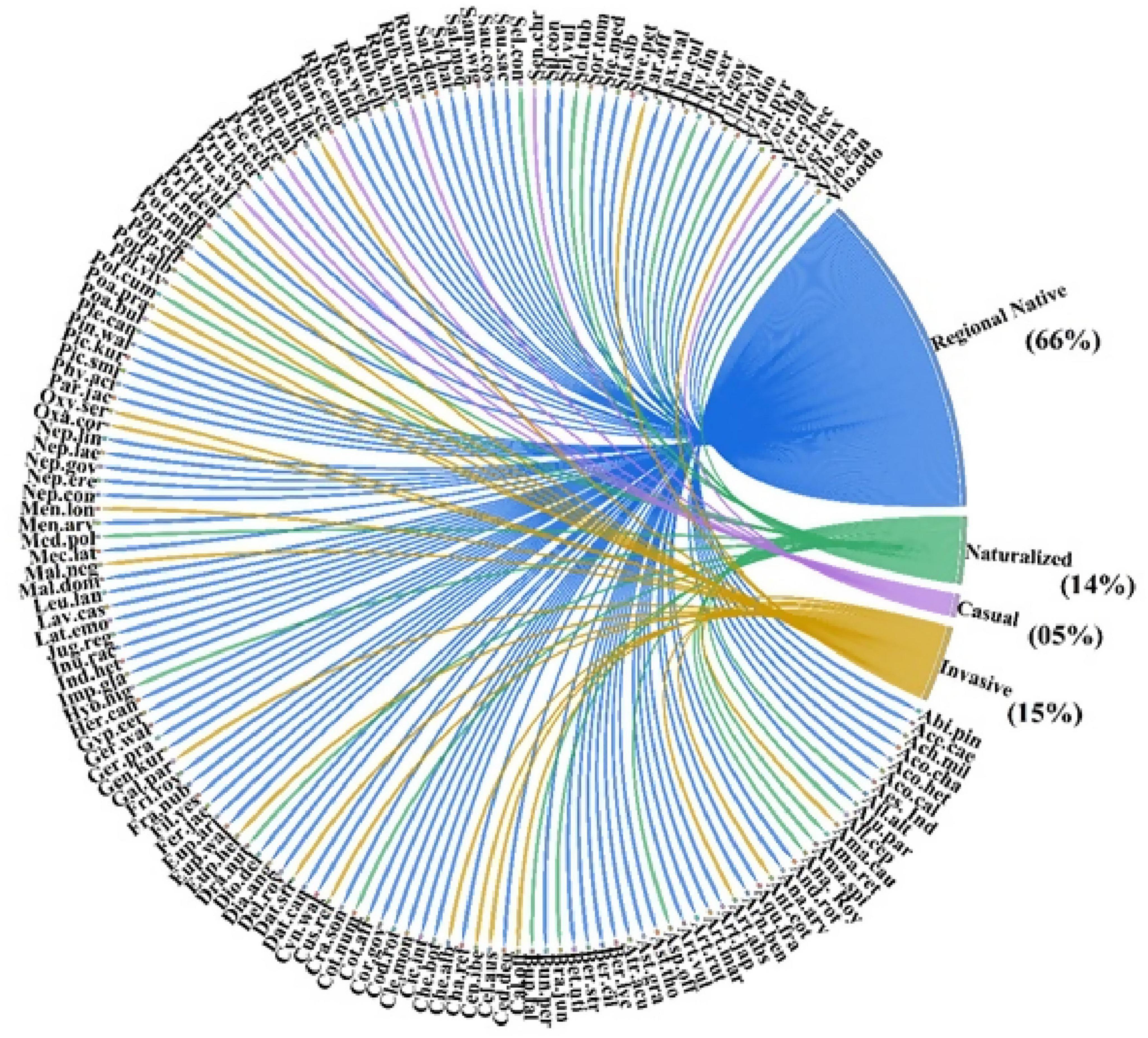
Figure 4. Plant species distribution according to nativity range of the vegetation in Gurez valley, Kashmir Himalaya, India.
Habitat-wise distribution
Of all species encountered 39% grew in the natural forests, 17% on dry slopes, 11% in shady places, 10% in moist places, 2% in riparian zones, 3% in rock crevices, and the remaining species were dispersed in highly distributed habitats, e.g., 11% along roadsides, 6% in crop fields, and 1% in vegetables gardens (Table 1 and Plate 2). Based on their floristic similarity, cluster analysis identified five clusters of various habitat types (Figure 5). Natural forests made up the first cluster, dry slopes and roadside vegetation made up the second, wet and shady areas made up the third, crop fields and vegetable gardens made up the fourth, and riparian vegetation and rock crevices made up the fifth (Figure 5).
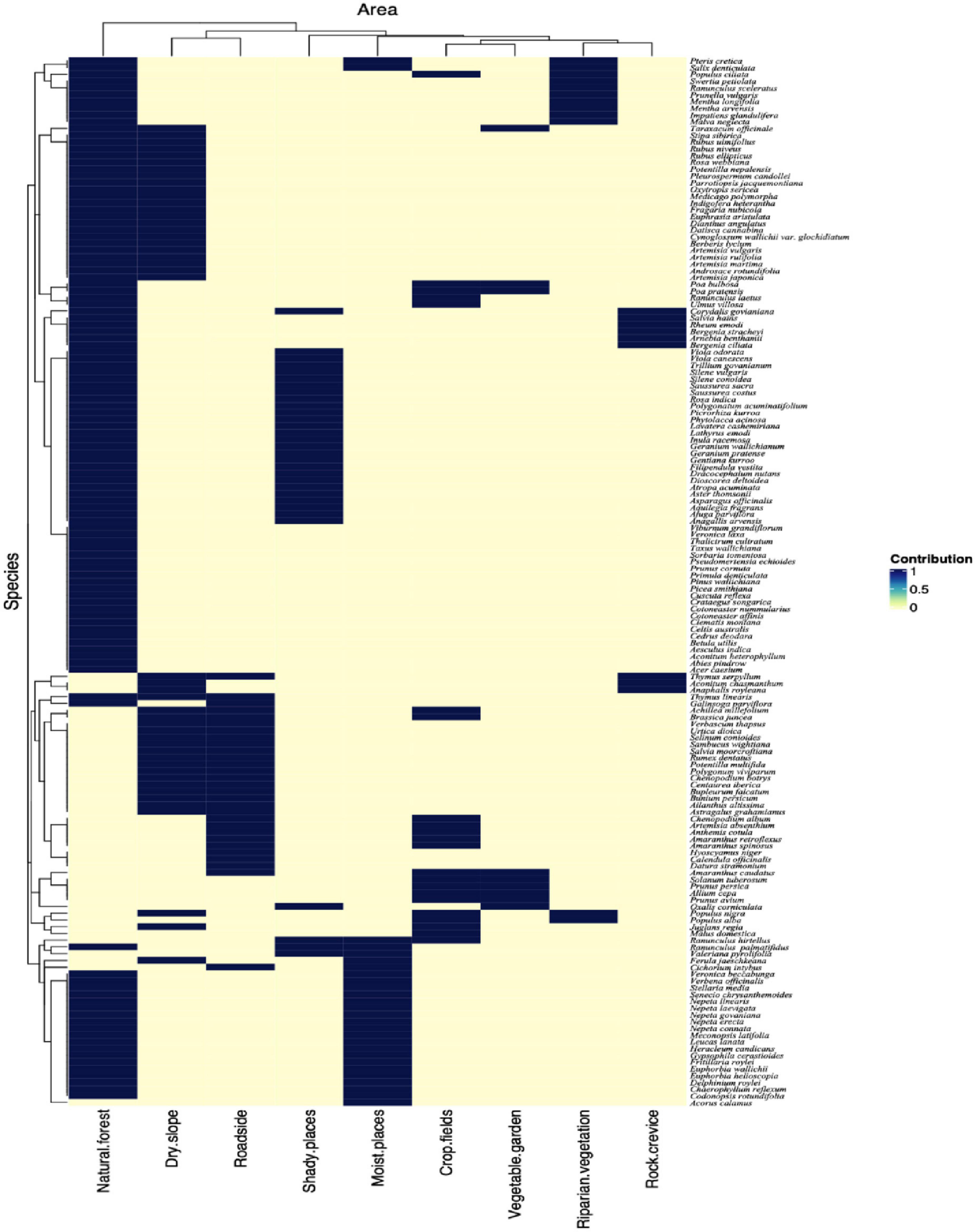
Figure 5. Heat map based on Sørensen’s (1948) similarity index of plant species in Gurez valley, Kashmir Himalaya, India.
Similar to this, the NMDS revealed significant variation in habitat types, with some species groups having a stronger association with particular habitat types than others (Figure 6). In the biplot, five clusters of habitats based on species presence/absence can be identified: dry slope; natural forest; roadside; moist places and rocky crevice; and crop fields, riparian vegetation, shady places, and vegetable gardens. The major plant species richness was detected in rich and optimally moisturized natural forest habitats and middle richness in moist places as well as less distributed habitations.
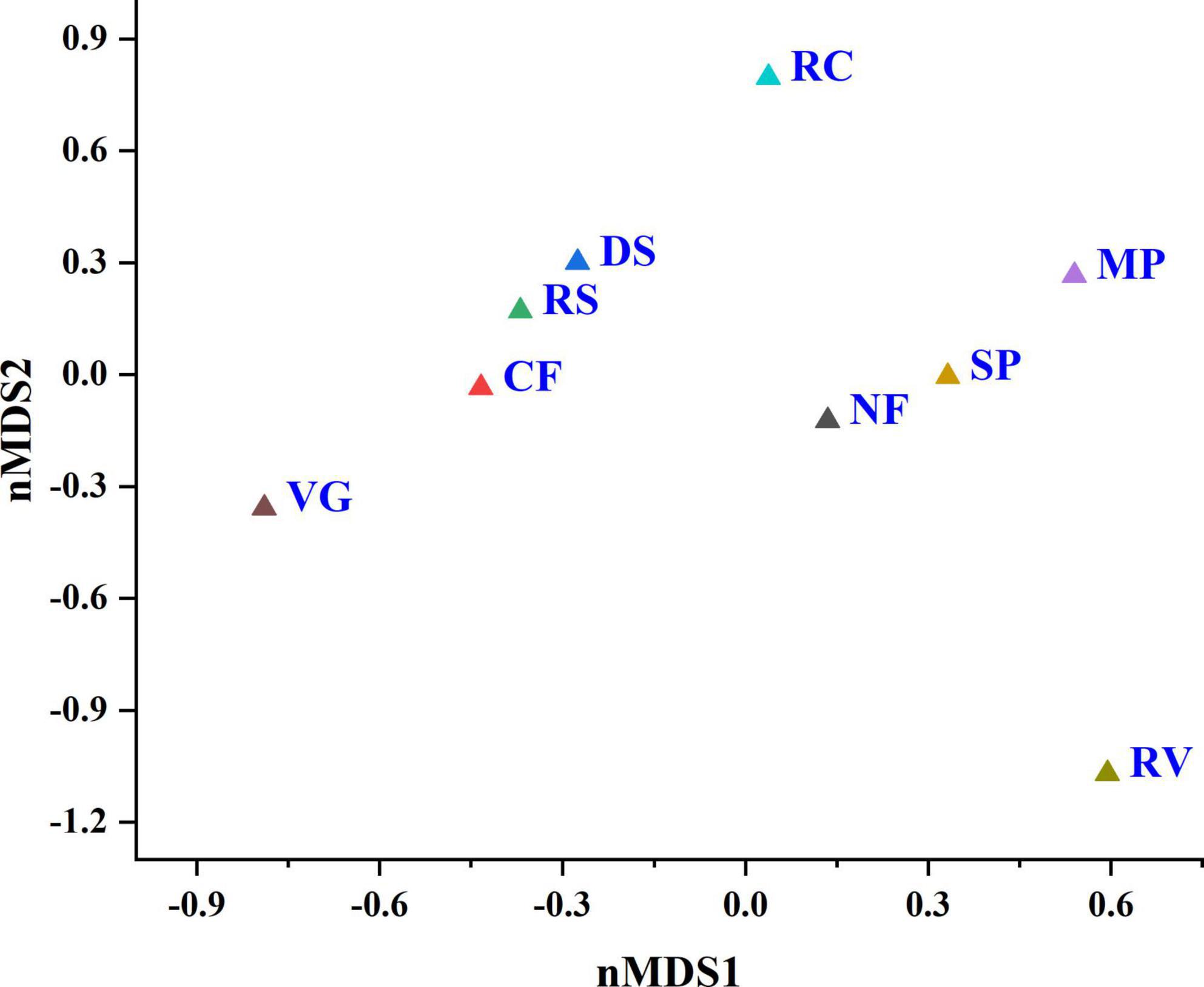
Figure 6. Non-Metric Multidimensional Scaling (NMDS) (plot of different habitat types in Gurez valley, Kashmir Himalaya, India. Full name of habitat is depicted in Table 1.
According to the estimated diversity indices, Natural forest had the greatest values for all three indices (Table 2). Shannon’s index for this habitat was 4.73, and Simpson’s was 0.99. There were 113 species present. After that, Dry slope and Shady areas held 46 and 31 specie (3.83 and 3.43 for Shannon index, and 0.98 and 0.97 for Simpson index, respectively) (Table 2) lowest values were recorded for Rock crevice and Vegetable garden (Table 2).
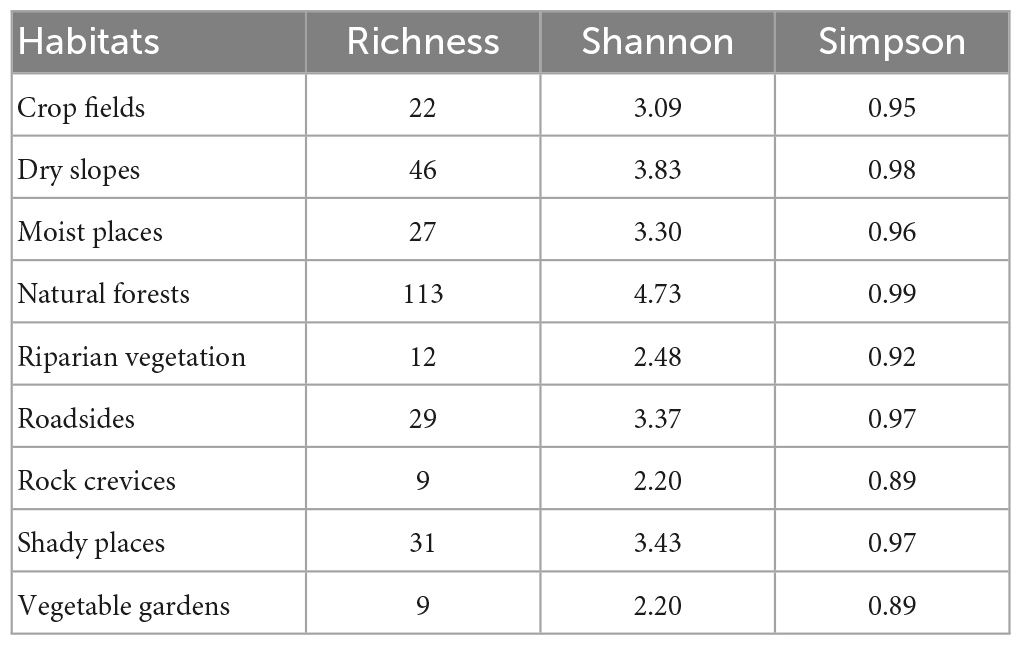
Table 2. Variation of diversity indices between habitat types in Gurez valley, Kashmir Himalaya, India.
Discussion
In this study, we provide an in-depth evaluation of the qualitative vegetation of remote region of Kashmir Himalaya. The study revealed (i) 155 plant species belonging to 120 genera and 49 families, with (ii) an uneven distribution within families, with 50% of the species belonging to just 7 families and 23 families being monotypic. (iii) Therophytes were the most prevalent form of life, showing that the vegetation was disturbed (iv) Exotic species made up the remaining 35% and most exotic plants were found along roadsides. Finally, (v) natural forests scored the highest values for all three estimated diversity indices, compared to other human-modified habitats. Vegetation analysis helps to develop a comprehensive image of the plant communities of a particular region (Chhetri and Shrestha, 2019). Assessing the floristic diversity of hotspots of biodiversity is essential to understand the conservation status of these areas, which have a significant role in making the conservation strategies as well as policies. The vegetation of region was found to be very diverse due to ecological zonation, different microhabitats, and topographic features. 49 families and 155 species were found in the current investigation. In comparison to past studies conducted in other Himalayan locations (Qureshi and Bhatti, 2010; Semwal et al., 2010; Shaheen and Qureshi, 2011; Dangwal et al., 2012; Singh and Rawat, 2012) the number of plant species recorded in the current research area was higher. Numerous interrelated factors, including elevation, regional climate, topography, competition, regional species pool, regional species dynamics, and human activity have an impact on the regional patterns of species richness (Rahman et al., 2020; Mitchell et al., 2023). However, Khan et al. (2012) reported a higher number of plant species (198) from the Naran valley forest of Pakistan Himalaya but distributed in a lower number of families (68) when compared to our study. Similarly, Verma and Kapoor (2011) reported 160 vascular plant species belongs to 51 families from Ropa-Giavung valley in the cold deserts of District Kinnaur, Himachal Pradesh, India (also see Manzoor et al., 2016; Haq et al., 2022d; Ullah et al., 2022). However, at the region level the species richness of our study was comparatively higher than report in previous studies from Kashmir Himalayas (Bhat et al., 2014). Thus, the slight but predictable fluctuation in species number might be attributed to both abiotic environmental and biotic causes. Apart from elevation, microhabitats that reflect or predict vegetation patterns across landscapes. Together with the previously described findings, our findings demonstrate that while various studies have analyzed the floristic composition of the Himalayan region, each micro-region has unique functional groups that can significantly affect the structuring of the local plant community. Our study showed a smaller number of species than several other studies, but had a larger number of families, which may also represent an important result for the analysis of biodiversity in these regions. Asteraceae, Rosaceae, Lamiaceae, Ranunculaceae, and Apiaceae were reported as the families with the largest number of plant species. Due to wide range of ecological amplitudes, the plant species of Asteraceae are varied in habitats (Rahman et al., 2019a; Rashid et al., 2021; Waheed et al., 2022). Similar findings were observed by Haq et al. (2021d) in Kashmir Himalaya, India and Rahman et al. (2018) in Manoor valley, Pakistan. Many researchers have reported Asteraceae as the dominant family from different regions (Verma and Kapoor, 2011; Hussain et al., 2015; Ali et al., 2016; Amjad et al., 2017; Khan et al., 2018; Rahman et al., 2019a). This demonstrates the family’s strong capacity for adaptation to a variety of environments and temperatures. Additionally, in agreement with our findings, two other studies—Suyal et al. (2010) in the Garhwal Himalaya, India, and Khan et al. (2015) in Kabal (Swat), Pakistan—reported Lamiaceae as the dominant family.
The current study emphasizes the uneven distribution of plant species throughout families, with 23 families being identified as monotypic. The large variety of families, which revealed a varied distribution of flora in the area, is explained by variances in microhabitat, morphological features, life duration, and dynamic ecological niche (Haq et al., 2022a; Khoja et al., 2022). The diversity and structure of these plant communities can be influenced by various abiotic and biotic factors, which has also been shown by earlier research in the Western Himalayan region, and some species and/or families may not be as able to inhabit particular habitats as others (Rahman et al., 2018). The growth form of trees had higher proportion (13%) than shrubs (10%), an expression of a functioning forest ecosystem (Khan et al., 2015). The present results agreed with Khan et al. (2015), who found that a large diversity of microhabitats was favorable to tree species in the region. The findings of Sharma and Raina (2018) from other Himalayan forests further support these findings. Herbaceous species (111) were the dominant habit similar to other areas of the Northwestern Himalaya (Dar and Sundarapandian, 2016; Rahman et al., 2019b; Haq et al., 2021a; Nafeesa et al., 2021). Previous research in the Western Himalayan region has shown that certain species and/or families rarely have the same ability to occupy specific habitats as others, where varied abiotic and biotic effects can alter the diversity and organization of these plant communities (Haq et al., 2021b; Nafeesa et al., 2021).
It has been observed that the most promising approaches for predicting the species composition of any forest communities revolves around their functional traits. Therefore, studying functional groups usually provides clear information on the direct physiological adaptations of plant communities to particular environments conditions (Haq et al., 2019). The most common life form class were therophytes, followed by hemicryptophytes, magaphanerophytes, chamaephytes, and geophytes. Such biological variety represents the adaptation of plant species to the climatic factors (Khan et al., 2018). Hemi-cryptophytes predominate in the study area due to the cold and mountainous climate. In general, they withstand water scarcity by remaining dry or developing physiological, morphological, and anatomical traits that allow them to tolerate water loss. The fact that therophytes were found as the dominant life form in the studied area, which indicates high biotic disturbance levels on the habitat via grazing, human settlements, agricultural practices, and road constructions, since this life form is commonly associated with the unfavorable dry environmental condition, resulting in adopted strategies for their survival (Vakhlamova et al., 2016). The current findings agreed with Asim et al. (2016), Rahman et al. (2018, 2019b), Wali et al. (2022) who also documented the dominance of therophytes in the respective research areas. The high biotic disturbance significantly alters composition of the herbaceous layer and favored the abundant growth of alien annual weedy species such as such as Anthemis cotula, Amaranthus caudatus, Centaurea iberica, Datura stramonium, and Galinsoga parviflora, all of which are therophytes (Haq et al., 2021d). The second most prevalent type of life was hemicryptophytes. The association of hemicryptophytes with a cold, mountainous climate is a likely explanation for their predominance (Shimwell, 1971). Because of the soil and climate in the subalpine zones, chamaephytes are more common (Khan et al., 2018). Some habitats are more suited to plant development than others based on the diversity of species found in the forest environments of different geographic regions (Medvecká et al., 2018). Comparing natural forest habitats to other types of habitat, the current study found that natural forest environments harbored the highest diversity of species. However, anthropogenic disturbances are fragmenting, destroying, and degrading natural forest habitats, which is affecting the composition and layout of forest communities including in this area of the Himalayan region (Chakraborty et al., 2017; Rahman et al., 2022). Qureshi and Bhatti (2010), who recorded the highest number of plant species in natural forest habitats from Pakistan, provide additional support for our findings. Moreover, the resemblance in the plant species pool in human modified habitats provides an evidence toward the indication of ecological filtration that occurs in the region (Gardner et al., 2009). Anthropogenic disturbances common in this Himalayan region include overgrazing, deforestation, over-exploitation and fragmentation of natural intact forests due to linear development such as road networks and transmission lines (Haq et al., 2022b). Out of the total reported plant species, 35% were exotic, mostly in human modified habitats. Such numbers are comparable with those documented by Kohli et al. (2004) from the forests of Himachal Pradesh of Indian Himalayas. The most common invasive species growing in forest ecosystems of Jammu and Kashmir included trees like Aesculus indica, Ailanthus altissima, Juglans regia, Populus ciliate, subshrub Sambucus wightiana, and herbs such as Anthemis cotula, Amaranthus caudatus, Centaurea iberica and Datura stramonium (Haq et al., 2019, 2023b). The invasion of plant species is typically facilitated by disturbance because it overwhelms environmental and physical barriers. The parameters that cause the disturbances have been seen to be able to filter the makeup of a community and affect species concurrence by altering resource and safe spot availability (Davis et al., 2000; Haq et al., 2022c,2023a). Generally, those species having wide niches and can pass via these filters and likely to overrun newly ecosystems after these are disturbed (Dukes and Mooney, 1999). Furthermore, invasions of exotics into forests might be facilitated by the incursion of other plant species generating conditions that encourage other invasive plant species over native species (Niu et al., 2007). When alien species invade a newly range, innate plant species, adaptation to the new environment, is sometimes evacuated (van Boheemen et al., 2019). The vegetation composition variations rise via a variety of procedure sensuing the disappearance of the diversity of plant species such as communities change from native desired plant species to monospecific positions of the invasive plant species (Pérez-Ramos et al., 2019; Haq et al., 2021c). Invasive species have broad consequences in affecting potential management to decrease the effects of climate changes (Kraft et al., 2015).
Implications for forest management and policy
According to our findings, 35% of plant species were deemed to be alien, indicating that a large number of non-native species have spread to the inaccessible and isolated Himalaya region. We discovered a high percentage of exotic species (such as Aesculus indica, Ailanthus altissima, Sambucus wightiana, Anthemis cotula, Amaranthus caudatus, Centaurea iberica, and Datura stramonium) in disturbed forest habitats such as roadsides, and we propose that tunnels, rather than roads, are the best opinions of connectivity in fragile mountain ecosystems. The elements that threaten biodiversity must be minimized in order to keep ecosystems operating and their members intact. Regulations that limit alien species like Anthemis cotula, Artemisia absinthium, Bupleurum falcatum, Cuscuta reflexa, Galinsoga parviflora, and Senecio chrysanthemoides, introductions, and boost recovery, such as modifying structure through enhanced species regeneration and planting native species (Abies pindrow, Cedrus deodara, Pinus roxburghii, P. wallichiana, Taxus wallichiana, Betula utilis, Ulmus villosa, Trillium govanianum, Ajuga parviflora). We found that the study area serves as the natural habitat for several significant, endangered medicinal plants, including Arnebia benthamii, Bergenia ciliata, Delphinium roylei, Gentiana kurroo, Phytolacca acinosa, Saussurea costus, and Trillium govanianum. Therefore, we recommend that human intervention in natural regeneration efforts be prioritized in these habitats to increase the population of these species. Finally, existing knowledge of threats to the forest flora can be used to guide management in the face of future climate change. The forest management strategy could be organized so that potential hazards (like forest fragmentation, invasion of exotic species) are addressed before they become a problem. Furthermore, the majority of species recovery initiatives should focus on managing forest restoration in human modified habitats through by planting and reseeding native species like, Ulmus villosa, Betula utilis, Aconitum heterophyllum, Trillium govanianum, Fritillaria roylei, Arnebia benthamii, to lessen susceptibility to future threats in the landscape.
Conclusion
The identification of areas with a high value for biodiversity and the prioritization of these areas for conservation are crucial for preserving biodiversity. The present investigation described qualitative vegetation characteristics in a remote region of the Kashmir Himalaya. The dominance of few families, especially the Asteraceae, is a result of actual and potential dominating invaders in zones with significant disturbance. Therophytes emerged to be the primary form of life in the research area. The presence of a large fraction of therophytes indicates major anthropogenic disruptions. The study examined how environmental factors affect plant communities and placed special emphasis on the idea of habitat filtration as it relates to plant species’ abiotic tolerance. Furthermore, by examining species features from a functional groups standpoint, it may be possible to predict an ecosystem functionality more accurately. The study’s findings suggest that decision-makers and planners should place a greater emphasis on ecologically sustainable development in forest landscapes, considering species composition and the preservation of ecosystem function. Similar approaches should undoubtedly ensure that development activities do not contribute to biodiversity loss in fragile ecosystems.
Data availability statement
The original contributions presented in this study are included in the article/supplementary material, further inquiries can be directed to the corresponding authors.
Author contributions
SH, FL, and AK collected the data. SH and MW analyzed and interpreted the data and results. SH wrote initial draft of the manuscript. SH, RB, EM, HE, and FL revised the manuscript. All authors read and approved the final manuscript.
Funding
This study was Researchers Supporting Project (RSP2023R118), King Saud University.
Acknowledgments
We would like to thank Researchers Supporting Project number (RSP2023R118), King Saud University, Riyadh, Saudi Arabia.
Conflict of interest
The authors declare that the research was conducted in the absence of any commercial or financial relationships that could be construed as a potential conflict of interest.
Publisher’s note
All claims expressed in this article are solely those of the authors and do not necessarily represent those of their affiliated organizations, or those of the publisher, the editors and the reviewers. Any product that may be evaluated in this article, or claim that may be made by its manufacturer, is not guaranteed or endorsed by the publisher.
Footnotes
References
Ali, A., Badshah, L., Hussain, F., and Shinwari, Z. K. (2016). Floristic composition and ecological characteristics of plants of Chail valley, district Swat, Pakistan. Pak. J. Bot. 48, 1013–1026.
Altaf, A., Haq, S. M., Shabnum, N., and Jan, H. A. (2022). Comparative assessment of phyto diversity in Tangmarg Forest division in Kashmir Himalaya, India. Acta Ecol. Sin. 42, 609–615. doi: 10.1016/j.chnaes.2021.04.009
Amjad, M. S., Arshad, M., Page, S., Qureshi, R., and Mirza, S. N. (2017). Floristic composition, biological spectrum and phenological pattern of vegetation in the subtropical forest of Kotli District, AJK, Pakistan. Pure Appl. Biol. 6, 426–447. doi: 10.19045/bspab.2017.60043
Asim, Z. I., Haq, F, Iqbal, A. (2016). Phenology, life form and leaf spectra of the vegetation of Kokarai valley, district swat. J. Bio. Environ. Sci. 9, 23–31.
Barkley, T. M., DePriest, P., Funk, V., Kiger, R. W., Kress, W. J., and Moore, G. (2004). Linnaean nomenclature in the 21st Century: A report from a workshop on integrating traditional nomenclature and phylogenetic classification. Taxon 53, 153–158. doi: 10.2307/4135501
Bhat, F., Mahajan, D. M., Sayyed, MRG, Bhat, A. (2014). Phytosociological measurements and vegetation analysis along an altitudinal gradient of Lolab valley (Kashmir Himalaya. India). WCS’s Natl. J. Inter. Res. 1, 1–13.
Chakraborty, A., Ghosh, A., Sachdeva, K., and Joshi, P. K. (2017). Characterizing fragmentation trends of the Himalayan forests in the Kumaon region of Uttarakhand, India. Ecol. Inform. 38, 95–99. doi: 10.1016/j.ecoinf.2016.12.006
Chhetri, N. B. K., and Shrestha, K. K. (2019). Floristic diversity and important value indices of tree species in lower Kanchenjunga Singhalila Ridge Eastern Nepal. Am. J. Plant Sci. 10, 248–263. doi: 10.4236/ajps.2019.101019
Dalirsefat, S. B., da Silva, A., Meyer, and Mirhoseini, S. Z. (2009). Comparison of similarity coefficients used for cluster analysis with amplified fragment length polymorphism markers in the silkworm Bombyx mori. J. Insect Sci. 9, 1–8. doi: 10.1673/031.009.7101
Dangwal, L. R., Singh, T., Singh, A., and Sharma, A. (2012). Plant diversity assessment in relation to disturbances in subtropical chirpine forest of the western Himalaya of district Rajouri, J&K, India. Int. J. Plant Anim. Environ. Sci. 2, 206–213.
Dar, J. A., and Sundarapandian, S. (2016). Patterns of plant diversity in seven temperate forest types of Western Himalaya, India. J. Asia Pac. Biodivers. 9, 280–292. doi: 10.1016/j.japb.2016.03.018
Davis, M. A., Grime, J. P., and Thompson, K. (2000). Fluctuating resources in plant communities: A general theory of invasibility. J. Ecol. 88, 528–534. doi: 10.1046/j.1365-2745.2000.00473.x
Dukes, J. S., and Mooney, H. A. (1999). Does global change increase the success of biological invaders?. Trends Ecol. Evol. 14, 135–139. doi: 10.1016/S0169-5347(98)01554-7
Gardner, T. A., Barlow, R., Chazdon, R. M., Ewers, C. A., Harvey, C. A., Peres, C., et al. (2009). Prospects for tropical forest biodiversity in a human-modified world. Ecol. Lett. 12, 561–582. doi: 10.1111/j.1461-0248.2009.01294.x
Grime, J. P., Hodgson, J. G., and Hunt, R. (2014). Comparative plant ecology: A functional approach to common British species. Berlin: Springer.
Gu, Z., Gu, L., Eils, R., Schlesner, M., and Brors, B. (2014). circlize implements and enhances circular visualization in R. Bioinformatics 30, 2811–2812. doi: 10.1093/bioinformatics/btu393
Haq, S. M., Calixto, E. S., and Kumar, M. (2020). Assessing biodiversity and productivity over a small-scale gradient in the protected forests of Indian Western Himalayas. J. Sustain. 40, 675–694. doi: 10.1080/10549811.2020.1803918
Haq, S. M., Lone, F. A., Kumar, M., Calixto, E. S., Waheed, M., Casini, R., et al. (2023b). Phenology and diversity of weeds in the agriculture and horticulture cropping systems of Indian Western Himalayas: Understanding implications for agro-ecosystems. Plants 12:1222. doi: 10.3390/plants12061222
Haq, S. M., Waheed, M., Khoja, A. A., Amjad, M. S., Bussmann, R. W., Ali, K., et al. (2023a). Measuring forest health at stand level: A multi-indicator evaluation for use in adaptive management and policy. Ecol. Indicat. 150:110225. doi: 10.1016/j.ecolind.2023.110225
Haq, S. M., Malik, Z. A., and Rahman, I. U. (2019). Quantification and characterization of vegetation and functional trait diversity of the riparian zones in protected forest of Kashmir Himalaya, India. Nord. J. Bot. 37:11. doi: 10.1111/njb.02438
Haq, S. M., Calixto, E. S., Rashid, I., and Khuroo, A. A. (2021d). Human-driven disturbances change the vegetation characteristics of temperate forest stands: A case study from Pir Panchal mountain range in Kashmir Himalaya. Trees For. People 6:100134. doi: 10.1016/j.tfp.2021.100134
Haq, S. M., Shah, A. A., Yaqoob, U., and Hassan, M. (2021a). Floristic quality assessment index of the Dagwan stream in Dachigam National Park of Kashmir Himalaya. Proc. Natl. Acad. Sci. India Sec B Biol. Sci. 91, 657–664. doi: 10.1007/s40011-021-01247-w
Haq, S. M., Yaqoob, U., Calixto, E. S., Kumar, M., Rahman, I. U., Hashem, A., et al. (2021b). Long-term impact of transhumance pastoralism and associated disturbances in high-altitude forests of Indian Western Himalaya. Sustainability 13:12497. doi: 10.3390/su132212497
Haq, S. M., Hamid, M., Lone, F. A., and Singh, B. (2021c). Himalayan hotspot with alien weeds: A case study of biological spectrum, phenology, and diversity of weedy plants of high-altitude Mountains in District Kupwara of J&K Himalaya, India. Proc. Natl. Acad. Sci. India Sec. B Biol. Sci. 91, 139–152. doi: 10.1007/s40011-020-01219-6
Haq, S. M., Khan, I., Malik, Z. A., and Singh, B. (2022d). “Plant diversity and species distribution pattern across the Pir Panjal mountain forest range in the Western Himalayas.” in Biodiversity, conservation and sustainability in Asia: Volume 2: Prospects and challenges in south and middle Asia, eds M. Öztürk, S. M. Khan, V. Altay, R. Efe, D. Egamberdieva, F. O. Khassanov (Cham: Springer International Publishing), 67–84.
Haq, S. M., Waheed, M., Bussmann, R. W., and Arshad, F. (2022a). Vegetation composition and ecological characteristics of the forest in the Shawilks Mountain Range from Western Himalayas. Acta Ecol. Sin. doi: 10.1016/j.chnaes.2022.10.008
Haq, S. M., Yaqoob, U., Hamid, S., Hassan, M., Bashir, F., Waheed, M., et al. (2022b). Localized impact of livestock settlements on vegetation patterns in fir forests of Kashmir Himalaya. Acta Ecol. Sin. 42, 407–416. doi: 10.1016/j.chnaes.2022.07.004
Haq, S. M., Amjad, M. S., Waheed, M., Bussmann, R. W., and Proæków, J. (2022c). The floristic quality assessment index as ecological health indicator for forest vegetation: A case study from Zabarwan Mountain Range, Himalayas. Ecol. Indic. 145:109670. doi: 10.1016/j.ecolind.2022.109670
Hua, F., Bruijnzeel, L. A., Meli, P., Martin, P. A., Zhang, J., Nakagawa, S., et al. (2022). The biodiversity and ecosystem service contributions and trade-offs of forest restoration approaches. Science 376, 839–844. doi: 10.1126/science.abl4649
Hussain, F., Shah, S. S., Badshah, L., and Durrani, M. J. (2015). Diversity and ecological characteristics of flora of Mastuj valley, district Chitral, Hindukush range, Pakistan. Pak. J. Bot. 47, 495–510.
Khan, S. M., Page, S., Ahmad, H., Shaheen, H., and Harper, D. M. (2012). Vegetation dynamics in the Western Himalayas, diversity indices and climate change. Sci. Tech. Dev. 31, 232–243.
Khan, W., Khan, S. M., and Ahmad, H. (2015). Altitudinal variation in plant species richness and diversity at Thandiani sub forests division, Abbottabad, Pakistan. JBES 7, 46–53.
Khan, W., Khan, S. M., Ahmad, H., Alqarawi, A. A., Shah, G. M., Hussain, M., et al. (2018). Life forms, leaf size spectra, regeneration capacity and diversity of plant species grown in the Thandiani forests, district Abbottabad, Khyber Pakhtunkhwa, Pakistan. Saudi J. Biol. Sci. 25, 94–100. doi: 10.1016/j.sjbs.2016.11.009
Khoja, A. A., Haq, S. M., Majeed, M., Hassan, M., Waheed, M., Yaqoob, U., et al. (2022). Diversity, ecological and traditional knowledge of pteridophytes in the western Himalayas. Diversity 14:628. doi: 10.3390/d14080628
Kier, G., Mutke, J., Dinerstein, E., Ricketts, T. T., Küper, W., Kreft, H., et al. (2005). Global patterns of plant diversity and floristic knowledge. J. Biogeogr. 32, 1107–1116. doi: 10.1111/j.1365-2699.2005.01272.x
Kohli, R. K., Dogra, K. S., Batish, D. R., and Singh, H. P. (2004). Impact of invasive plants on the structure and composition of natural vegetation of Northwestern Indian Himalayas1. Weed Technol. 18, 1296–1300. doi: 10.1614/0890-037X(2004)018[1296:IOIPOT]2.0.CO;2
Kraft, N. J., Adler, P. B., Godoy, O., James, E. C., Fuller, S., and Levine, J. M. (2015). Community assembly, coexistence and the environmental filtering metaphor. Funct. Ecol. 29, 592–599. doi: 10.1111/1365-2435.12345
Mahar, G., Dhar, U., Rawal, R. S., and Bhatt, I. D. (2009). Implications of location specific data and their usefulness in conservation planning: An example from Indian Himalayan Region (IHR). Biodivers. Conserv. 18, 1273–1286. doi: 10.1007/s10531-008-9450-0
Manzoor, M., Riaz, A., Iqbal, Z., and Mian, A. (2016). Biodiversity of Pir Lasura National Park, Azad Jammu and Kashmir, Pakistan. Sci. Tech. Dev. 82, 182–196.
Medvecká, J., Jarolímek, I., Hegedüšová, K., Škodová, I., Bazalová, D., Botková, K., et al. (2018). Forest habitat invasions–Who with whom, where and why. For. Ecol. Manag. 409, 468–478. doi: 10.1016/j.foreco.2017.08.038
Mitchell, J. C., Kashian, D. M., Chen, X., Cousins, S., Flaspohler, D., Gruner, D. S., et al. (2023). Forest ecosystem properties emerge from interactions of structure and disturbance. Front. Ecol. Environ. 21:14–23. doi: 10.1002/fee.2589
Myers, N., Mittermeier, R. A., Mittermeier, C. G., Da Fonseca, G. A., and Kent, J. (2000). Biodiversity hotspots for conservation priorities. Nature 403, 853–858. doi: 10.1038/35002501
Nafeesa, Z., Haq, S. M., Bashir, F., Gaus, G., Mazher, M., Anjum, M., et al. (2021). Observations on the floristic, life-form, leaf-size spectra and habitat diversity of vegetation in the Bhimber hills of Kashmir Himalayas. Acta Ecol. Sin. 41, 228–234. doi: 10.1016/j.chnaes.2021.03.003
Niu, H. B., Liu, W. X., Wan, F. H., and Liu, B. (2007). An invasive aster (Ageratina adenophora) invades and dominates forest understories in China: Altered soil microbial communities facilitate the invader and inhibit natives. Plant Soil 294, 73–85. doi: 10.1007/s11104-007-9230-8
Noss, R. F. (1983). A regional landscape approach to maintain diversity. BioScience 33, 700–706. doi: 10.2307/1309350
Olson, D. M., Dinerstein, E., Wikramanayake, E. D., Burgess, H. D., Powell, G. V., and Underwood, C. E. (2001). Terrestrial ecoregions of the world: A new map of life on earth a new global map of terrestrial ecoregions provides an innovative tool for conserving biodiversity. BioScience 51, 933–938. doi: 10.1641/0006-3568(2001)051[0933:TEOTWA]2.0.CO;2
Pérez-Harguindeguy, N., Diaz, S., Garnier, E., Lavorel, S., Poorter, H., Jaureguiberry, P., et al. (2016). Corrigendum to: New handbook for standardised measurement of plant functional traits worldwide. Aust. J. Bot. 64, 715–716. doi: 10.1071/BT12225_CO
Pérez-Ramos, I. M., Matías, L., Gómez-Aparicio, L., and Godoy, O. (2019). Functional traits and phenotypic plasticity modulate species coexistence across contrasting climatic conditions. Nat. Commun. 10:2555. doi: 10.1038/s41467-019-10453-0
Qian, H., Zhou, Y., Zhang, J., Jin, Y., Deng, T., and Cheng, S. (2021). A synthesis of botanical informatics for vascular plants in Africa. Ecol. Inform. 64:101382. doi: 10.1016/j.ecoinf.2021.101382
Qureshi, R., and Bhatti, G. R. (2010). Floristic inventory of PAI Forest, Nawab Shah, Sindh, Pakistan. Pak. J. Bot. 42, 2215–2224.
R Core Team (2020). A language and environment for statistical computing. Vienna: R Foundation for Statistical Computing.
Rahman, I. U., Afzal, A., Iqbal, Z., Abd Allah, E., Alqarawi, A. A., Calixto, E. S., et al. (2019a). Role of multivariate approaches in floristic diversity of Manoor Valley (Himalayan Region), Pakistan. Appl. Ecol. Environ. Res. 17, 1475–1498. doi: 10.15666/aeer/1702_14751498
Rahman, I. U., Calixto, E. S., Afzal, A., Iqbal, Z., Ali, N., Ijaz, F., et al. (2019b). “Advanced multivariate and computational approaches in agricultural studies,” in Essentials of bioinformatics, Vol. III, eds K. Hakeem, N. Shaik, B. Banaganapalli, and R. Elango (Cham: Springer), 93–102. doi: 10.1007/978-3-030-19318-8_5
Rahman, I. U., Afzal, A., Iqbal, Z., Bussmann, R. W., Alsamadany, H., Calixto, E. S., et al. (2020). Ecological gradients hosting plant communities in Himalayan subalpine pastures: Application of multivariate approaches to identify indicator species. Ecol. Inform. 60:101162. doi: 10.1016/j.ecoinf.2020.101162
Rahman, I. U., Afzal, A., Iqbal, Z., Ijaz, F., Ali, A., Asif, M., et al. (2018). First insights into the floristic diversity, biological spectra and phenology of Manoor Valley, Pakistan. Pak. J. Bot. 5, 1113–1124.
Rahman, I. U., Hart, R. E., Ijaz, F., Afzal, A., Iqbal, Z., and Calixto, E. S. (2022). Environmental variables drive plant species composition and distribution in the moist temperate forests of Northwestern Himalaya, Pakistan. PLoS One 17:e0260687. doi: 10.1371/journal.pone.0260687
Rashid, I., Haq, S. M., Lembrechts, J. J., Khuroo, A. A., Pauchard, A., and Dukes, J. S. (2021). Railways redistribute plant species in mountain landscapes. J. Appl. Ecol. 58, 1967–1980. doi: 10.1111/1365-2664.13961
Raunkiaer, C. (1934). The life forms of plants and statistical geographical. Oxford: Clarendon Press, 632.
Safidkon, F., R. Kalvandi, M. Atri and M.M. Barazandeh. (2003). Contribution for the characterization of Thymus eriocalyx chemotypes. Int. Mag. Cosmet. Fragr.
Semwal, D. P., Uniyal, P. L., and Bhatt, A. B. (2010). Structure, composition and dominance–diversity relations in three forest types of a part of Kedarnath Wildlife Sanctuary, Central Himalaya, India. Not. Sci. 2, 128–132. doi: 10.15835/nsb234655
Shaheen, H., and Qureshi, R. A. (2011). Vegetation types of Sheosar Lake and surrounding landscape in Deosai Plains of North Pakistan, Western Himalayas. J. Med. Plant Res. 5, 599–603.
Sharma, J., and Raina, A. K. (2018). Quantitative analysis, distributional pattern and species diversity of woody plant species of Lamberi Forest Range, Rajouri, J&K, India. J. Nat. Appl. Sci. 10, 522–527. doi: 10.31018/jans.v10i1.1661
Shimwell, D. W. (1971). The description and classification of vegetation. London: Sedgwick and Jackson, 322.
Singh, G., and Rawat, G. S. (2012). “Depletion of oak (Quercus spp.) forests in the western Himalaya: Grazing, fuelwood and fodder collection,” in Global perspectives on sustainable forest management, ed. C. A. Okia (Crotia: Intech publisher), 29–42. doi: 10.5772/33554
Solefack, M. C. M., Fedoung, E. F., and Temgoua, L. F. (2018). Factors determining floristic composition and functional diversity of plant communities of Mount Oku forests, Cameroon. Asia Pac. Biodivers. 11, 284–293. doi: 10.1016/j.japb.2018.03.005
Sørensen, T. (1948). A method of establishing groups of equal amplitude in plant sociology based on similarity of species content and its application to analyses of the vegetation on Danish commons. Videnski Selskab Biologiske Skrifter 5, 1–34.
Suyal, S., Sharma, C. M., Gairola, S., Ghildiyal, S., Rana, C., Butola, D. S. (2010). Phyto diversity (angiosperms and gymnosperms) in Chaurangikhal forest of Garhwal Himalaya, Uttarakhand, India. Indian J. Sci. Tech. 3, 267–275. doi: 10.17485/ijst/2010/v3i3.2
Ullah, U., Rahim, F., Jan, H. A., Haq, S. M., Wali, S., and Filimban, F. Z. (2022). A survey of the floristic composition of the Kambat Valley, District Dir Lower, Northern Pakistan. Acta Ecol. Sin. doi: 10.1016/j.chnaes.2022.08.002
Vakhlamova, T., Rusterholz, H. P., Kanibolotskaya, Y., and Baur, B. (2016). Effects of road type and urbanization on the diversity and abundance of alien species in roadside verges in Western Siberia. Plant Ecol. 217, 241–252. doi: 10.1007/s11258-016-0565-1
van Boheemen, L. A., Atwater, D. Z., and Hodgins, K. A. (2019). Rapid and repeated local adaptation to climate in an invasive plant. New Phytol. 222, M614–M627. doi: 10.1111/nph.15564
Verma, R. K., and Kapoor, K. S. (2011). Plant species diversity in Ropa-Giavung valley in cold deserts of District Kinnaur, Himachal Pradesh. Biol. Forum Int. J. 3, 34–43.
Waheed, M., Haq, S. M., Arshad, F., Bussmann, R. W., Iqbal, M., Bukhari, N. A., et al. (2022). Grasses in semi-arid lowlands—community composition and spatial dynamics with special regard to the influence of edaphic factors. Sustainability 14:14964. doi: 10.3390/su142214964
Keywords: plant invasion, habitat diversity, hotspots of biodiversity, ecological traits, Kashmir Himalaya
Citation: Haq SM, Khoja AA, Lone FA, Waheed M, Bussmann RW, Mahmoud EA and Elansary HO (2023) Floristic composition, life history traits and phytogeographic distribution of forest vegetation in the Western Himalaya. Front. For. Glob. Change 6:1169085. doi: 10.3389/ffgc.2023.1169085
Received: 18 February 2023; Accepted: 15 May 2023;
Published: 02 June 2023.
Edited by:
Yashwant Singh Rawat, Federal Technical and Vocational Education and Training Institute (FTVETI), EthiopiaReviewed by:
Kauane Maiara Bordin, Federal University of Rio Grande do Sul, BrazilD. S. Chauhan, Hemwati Nandan Bahuguna Garhwal University, India
Shreekar Pant, Baba Ghulam Shah Badshah University, India
Copyright © 2023 Haq, Khoja, Lone, Waheed, Bussmann, Mahmoud and Elansary. This is an open-access article distributed under the terms of the Creative Commons Attribution License (CC BY). The use, distribution or reproduction in other forums is permitted, provided the original author(s) and the copyright owner(s) are credited and that the original publication in this journal is cited, in accordance with accepted academic practice. No use, distribution or reproduction is permitted which does not comply with these terms.
*Correspondence: Shiekh Marifatul Haq, bWFyaWZhdC5lZHUuMTdAZ21haWwuY29t; Hosam O. Elansary, aGVsYW5zYXJ5QGtzdS5lZHUuc2E=
 Shiekh Marifatul Haq
Shiekh Marifatul Haq Aadil Abdullah Khoja
Aadil Abdullah Khoja Fayaz A. Lone3
Fayaz A. Lone3 Muhammad Waheed
Muhammad Waheed Rainer W. Bussmann
Rainer W. Bussmann Eman A. Mahmoud
Eman A. Mahmoud Hosam O. Elansary
Hosam O. Elansary